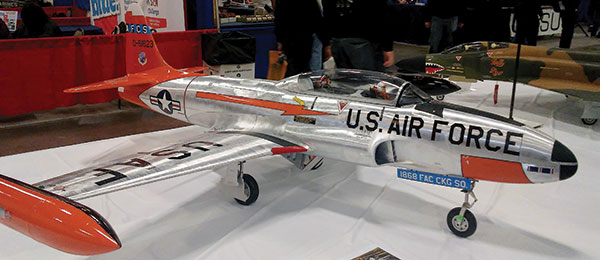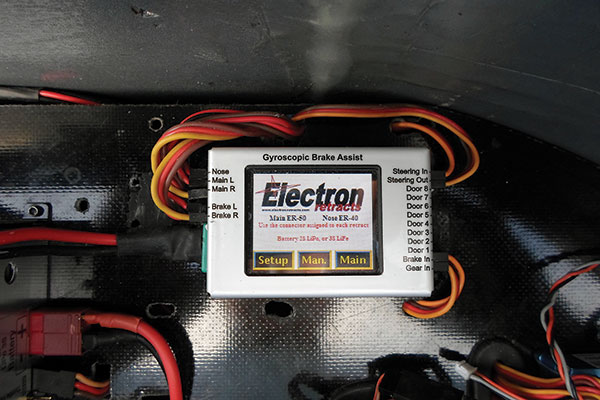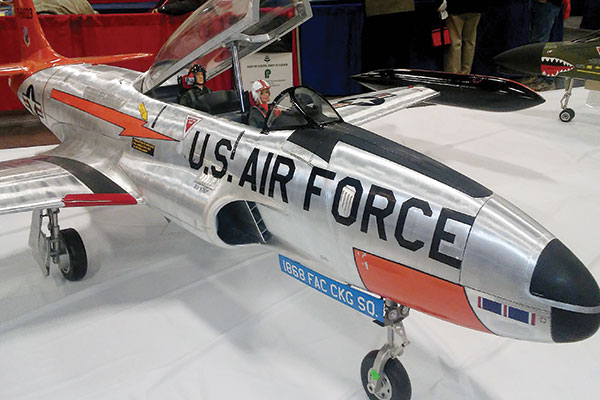Electric Retractable Landing Gear

Written by Jim Hiller RC Jets Column As seen in the September 2017 issue of Model Aviation.
A trend in the jet community is the use of electric retractable landing gear instead of the popular air retract systems. I have been flying pneumatic landing gear and understand the issues unique to this equipment and how to deal with its problems. I have had reliable landing gear systems. The failures I experienced centered around the nose gear either hanging up on the steering cables or on the nose gear door. Failures related to the air system are rare. I am converting my Xtreme A.R.F. Vixen from pneumatic landing gear to Electron Retracts electric landing gear. The motivation was an upgrade in strength to handle grass field operations. The factory landing gear has served me well, but has limited me to flying on paved runways. I have seen the strength and reliability of the Electron Retracts landing gear, struts, brakes, and controller, and feel that this system will be more than adequate for grass field operations. The well-made Vixen landing gear mounts are rigid and strong, so I do not expect any problems with the airframe from the increased loads when landing on grass. The Electron Retracts landing gear system that I am installing has several nice features. The trailing link-type struts on the main gear and the nose gear are proven advantages when flying from grass; after all, the Russians used them on their 1950s jets that were designed for grass field operations. These struts are strong. They are rated conservatively compared with many competitors’ gear struts. The nose gear features the steering servo mounted on the retract unit and the servo travels with the gear struts, eliminating troublesome cables. Instead, a direct short linkage connects the nose gear strut to the servo. This is a simple, tight, and reliable system. The trunnion for mounting the landing gear strut is robust. This retract unit has a history of durability and the main gear retract units and strut are as strong. These brakes have been on the market for a while and have some history, and the employees at Electron Retracts continue to improve the braking system. Electron Retracts also has its own electric brakes on the main gear, eliminating the need for pneumatic systems. The Vixen will be an all-electric airplane.

The heart of any landing gear system is in the controls. The Electron Retracts GS-200 gyroscopic landing gear controller and door sequencer is an all-in-one unit. It’s capable of controlling up to eight gear door outputs, three electric retractable landing gear, and two electric brakes—all with a built-in gyro to help tame the steering duties.
Electric brakes need to be kept clean to maintain consistent braking without pulling when they are applied. Another issue that can cause a jet to pull during braking is an uneven air gap of the brake disc, which is possibly caused by uneven wear. Swapping out the brake disc between the two wheels should fix this. The best feature of the Electron Retracts system is the GS-200 gyroscopic landing gear controller and sequencer. This unit has many nice features. First, it is a gear door sequencer with up to eight outputs for servos and provides many options with each output. Each output is individually programmed, along with the timing of the landing gear, for a total of 10 programmed steps. Outputs for the servo-driven landing gear doors have individual end points, servo speed, and door positioning with the landing gear up, the gear in, and with the landing gear down. The time between each step is set to allow for proper sequence timing as the landing gear extends or retracts—possibly creating some sophisticated operations. With a little imagination, these steps could be used to control other operations such as opening and closing a canopy. The uses could be endless. Another feature relates to the nose gear steering. It is centered whenever the nose gear is retracted. Note that the servo is centered relative to the servo center setting in the control unit. Any trim inputs—even sub-trims from the transmitter—will not affect the servo center in the retracted position. This is important on close-fitting wheel wells where the nose gear can easily hang up on the side of the gear well. My favorite feature is a built-in gyro with adjustable gains that is available for use on the nose gear steering servo and, even better, to control individual braking. This remarkable unit will allow individual braking with gyro control for those times when it gets away from you. This is a feature that I would really like on a tail-dragger airplane, especially when operating it on a paved runway. It makes me think about using it on some of my other aircraft to tame tail-dragger habits. Use the built-in screen with a simple menu system to program the GS-200 controller. It takes some practice to walk through the programming, but as you become more familiar with the GS-200, the better your programming skills will become. Start with a simple setup for your first model. You will later find that it’s capable of being used with sophisticated sequences on models (such as an F-18 Hornet) that have many gear doors, closed gear doors, or doors closed with the gear extended. The GS-200 controller is powered directly from the receiver for servo control. It can handle a high-voltage setup. I use a high-voltage two-cell LiPo battery for the radio power, which is no problem for this unit. A separate battery powers the landing gear and brakes. I utilize a 2,000 mAh two-cell LiPo battery for power, with plenty of excess power for normal flying. The GS-200 can handle up to 12 volts for brakes and retract units. The Electron retracts and brakes that I use, however, are set up for 8.4-volt operation.
Jordan Hall
Meet Jordan Hall, who built the stunning Skymaster Lockheed T-33 that earned the People’s Choice Award at this year’s Toledo Show: R/C Model Expo. The event was held April 7-9 in Toledo, Ohio. The airplane is a masterpiece. This is the first scale jet model that Jordan has built at such an award-winning level. The aircraft is covered with Flite-Metal aluminum—a quality product that provides a beautiful finish. Nothing beats a T-33 in natural aluminum.
The detail in Jordan’s Lockheed T-33 has to be seen up close to truly appreciate its craftsmanship. Excellent work.
This model is powered by a JetCat P180-RXi turbine. This engine is a bit of overkill, but there’s nothing like excess power to get the airplane out of trouble. The engine can, with good throttle control, perform aerobatics in a scalelike manner. The Skymaster T-33 has a 104-inch wingspan, so it is no small endeavor. It stands out in any crowd and requires good power to fly. The model’s overall weight comes in at 41 pounds, which is a good, light weight for a Skymaster T-33. The Flite-Metal aluminium doesn’t require paint underneath, so there is not a significant weight increase. The effort required to obtain such a finish is explained in Jordan’s “Skymaster T-33 Build” thread that she started on RCUniverse in the RC Jets section. The system’s installation is also included in the thread, but the discussion about how she obtained the fine finish with the aluminum and just the right shine and appearance are discussed in detail. Fine arts are required when using Flite-Metal aluminum. Congratulations to Jordan on creating such a fine work of art and on the awards she has won. I look forward to the Skymaster’s test flight, which might be occurring as I write this article! Best of luck!










Add new comment